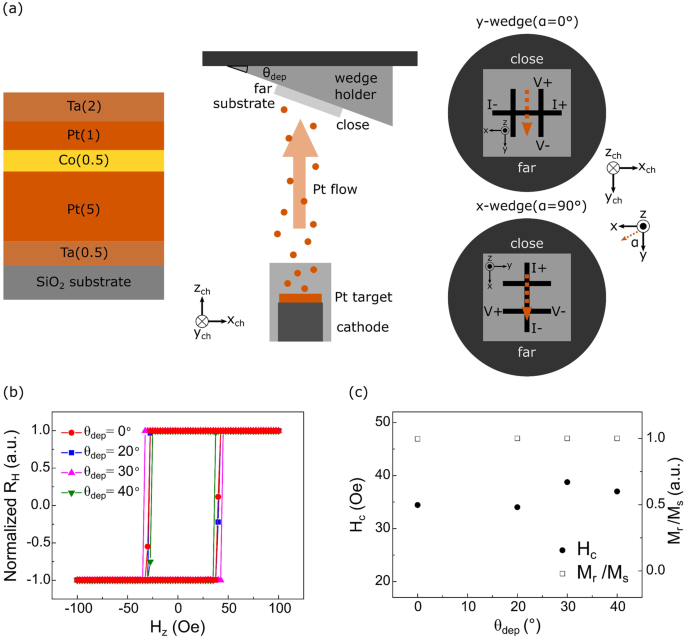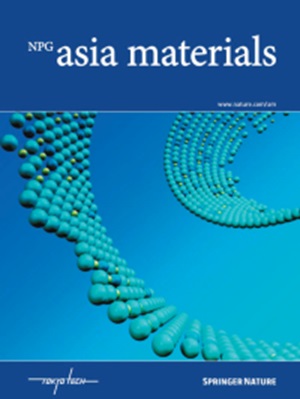The central role of tilted anisotropy for field-free spin–orbit torque switching of perpendicular magnetization
IF 8.3
2区 材料科学
Q1 MATERIALS SCIENCE, MULTIDISCIPLINARY
引用次数: 0
Abstract
The discovery of efficient magnetization switching upon device activation by spin Hall effect (SHE)-induced spin–orbit torque (SOT) changed the course of magnetic random-access memory (MRAM) research and development. However, for electronic systems with perpendicular magnetic anisotropy (PMA), the use of SOT is still hampered by the necessity of a longitudinal magnetic field to break magnetic symmetry and achieve deterministic switching. In this work, we demonstrate that robust and tunable field-free current-driven SOT switching of perpendicular magnetization can be controlled by the growth protocol in Pt-based magnetic heterostructures. We further elucidate that such growth-dependent symmetry breaking originates from the laterally tilted magnetic anisotropy of the ferromagnetic layer with PMA, a phenomenon that has been largely neglected in previous studies. We show experimentally and in simulation that in a PMA system with tilted anisotropy, the deterministic field-free switching exhibits a conventional SHE-induced damping-like torque feature, and the resulting current-induced effective field shows a nonlinear dependence on the applied current density. This relationship could be potentially misattributed to an unconventional SOT origin. This study explores a novel approach to achieve field-free current-driven spin–orbit torque switching of perpendicular magnetization for MRAM applications. By adjusting growth protocols in Pt-based magnetic heterostructures, a previously overlooked laterally tilted texture and magnetic anisotropy are harnessed. These findings allow deterministic switching of perpendicular magnetization without an external magnetic field. Contrary to conventional assumptions, the observed nonlinear dependence on current density resembles a damping-like torque, challenging previous notions about its origin.


倾斜各向异性在垂直磁化的无场自旋轨道力矩切换中的核心作用
自旋霍尔效应(SHE)诱导的自旋轨道力矩(SOT)可在器件激活时实现高效磁化切换,这一发现改变了磁性随机存取存储器(MRAM)的研究和开发进程。然而,对于具有垂直磁各向异性(PMA)的电子系统来说,由于需要纵向磁场来打破磁对称性并实现确定性开关,SOT 的使用仍然受到阻碍。在这项工作中,我们证明了在铂基磁异质结构中,垂直磁化的稳健、可调的无磁场电流驱动 SOT 开关可由生长协议控制。我们进一步阐明,这种依赖于生长的对称性破坏源于具有 PMA 的铁磁层的横向倾斜磁各向异性,而这一现象在以往的研究中基本上被忽视了。我们通过实验和仿真表明,在具有倾斜各向异性的 PMA 系统中,确定性无磁场切换表现出传统的 SHE 诱导阻尼转矩特征,由此产生的电流诱导有效磁场与外加电流密度呈非线性依赖关系。这种关系有可能被误认为是非常规 SOT 的起源。
本文章由计算机程序翻译,如有差异,请以英文原文为准。
求助全文
约1分钟内获得全文
求助全文
来源期刊

Npg Asia Materials
MATERIALS SCIENCE, MULTIDISCIPLINARY-
CiteScore
15.40
自引率
1.00%
发文量
87
审稿时长
2 months
期刊介绍:
NPG Asia Materials is an open access, international journal that publishes peer-reviewed review and primary research articles in the field of materials sciences. The journal has a global outlook and reach, with a base in the Asia-Pacific region to reflect the significant and growing output of materials research from this area. The target audience for NPG Asia Materials is scientists and researchers involved in materials research, covering a wide range of disciplines including physical and chemical sciences, biotechnology, and nanotechnology. The journal particularly welcomes high-quality articles from rapidly advancing areas that bridge the gap between materials science and engineering, as well as the classical disciplines of physics, chemistry, and biology. NPG Asia Materials is abstracted/indexed in Journal Citation Reports/Science Edition Web of Knowledge, Google Scholar, Chemical Abstract Services, Scopus, Ulrichsweb (ProQuest), and Scirus.
 求助内容:
求助内容: 应助结果提醒方式:
应助结果提醒方式:


